Small Mammals
Credit: CDC would like to thank Kristine Smith DVM, a Diplomate of the American College of Zoological Medicine, and Tom Edling, DVM, MSpVM, MPH for their careful review of these pages.
The terms “small mammals” or “pocket pets,” refer to small animals, often rodents, which are kept as pets and could fit into your pocket. Common small mammal pets include:

- Rats
- Mice
- Hamsters
- Gerbils
- Guinea pigs
- Pygmy hedgehogs
- Sugar gliders
- Other small animals
Small mammals also include a few animals that are not so small, such as rabbits and prairie dogs.
Owning a small mammal can be a big responsibility, even though the animal itself may be tiny. If you decide that a small mammal is the right pet for you, you need to learn how to take care of it properly and be aware of diseases that it might carry. With routine veterinary care and some simple health habits, you are less likely to get sick from touching, petting, or owning a small mammal.
Some of the diseases associated with small mammal pets that can cause human illness include:
Campylobacteriosis (Campylobacter spp.)
Campylobacter is a type of bacteria that spreads through contaminated food (meat and eggs), water, or contact with stool of infected animals. Campylobacter infections are rare in small mammals but have been associated with rodents, such as hamsters, guinea pigs, and gerbils. Small mammals infected with Campylobacter may not show any signs of illness at all or may have diarrhea.
Most people who become sick with campylobacteriosis will have diarrhea, cramping, abdominal pain, and fever within 2 to 5 days after exposure. Campylobacter can cause serious life-threatening infections in infants, elderly persons, and other people with weakened immune systems.
Cheyletiellosis (Rabbit fur mites; Cheyletiella spp.)
Rabbit fur mites (Cheyletiella spp.) are tiny parasites that can be found on some healthy rabbits. These mites generally do not cause disease in people or animals. Adult mites may be easily seen on an affected animal. They are often white and may look like “walking dandruff” if they are observed moving. Affected rabbits may have hair loss, dandruff, and itching as a result of skin irritation from the mite.
People may get Cheyletiella mites when they pet or hold an infested rabbit. Chyletiella can temporarily infest humans, causing skin irritation and itching. The best way to prevent infestation in rabbits is to use an insecticide approved by your veterinarian.
Giardiasis (Giardia spp.)
Giardia is a parasite that causes diarrheal illness in animals and people. Giardia is transmitted to animals and people through food or water contaminated with stool. This parasite is relatively uncommon in small mammals but has been associated with chinchillas, rats, and mice.
Symptoms for animals and people include diarrhea, greasy stools, and dehydration. People can also have abdominal cramps, nausea, and vomiting. Symptoms can last 1 to 2 weeks.
Lymphocytic Choriomeningitis Virus (LCMV)
Lymphocytic choriomeningitis (LCM) is a rare viral disease that can be transmitted through the urine, droppings, saliva, or cage material of infected wild and domestic rodents, including hamsters, guinea pigs, rats, mice, and other small rodents. Infected small rodents often appear normal or have small decreases in activity and appetite. Later, these infected animals may show more significant signs of weight loss, hunched posture, and ultimately die.
Human infections with LCMV are rare, especially from pet rodents. If people are infected, they generally have symptoms similar to those of the common flu. These symptoms include fever, stiff neck, loss of appetite, muscle aches, headache, nausea, and vomiting and often occur 1 to 2 weeks after exposure. People with weakened immune systems, especially young children and pregnant women, are the most at risk.
Sarcoptic Mange (Trixacarus caviae)
Sarcoptic mange is a parasitic skin disease that is caused by a tiny mite and is transmitted between animals through close contact. Sarcoptic mange is rare but has been associated with guinea pigs.
People cannot become infested with the animal versions of sarcoptic mange, but they can have a minor local reaction from the mites if they come in contact with an infested animal.
Monkeypox Virus *not currently in the United States
Monkeypox is a rare viral disease that usually found in central and western Africa but can infect rats, mice, rabbits, and prairie dogs. Infected pets may appear healthy with no clinical signs of disease or may develop fever, cough, conjunctivitis, and lymphadenopathy, followed by a nodular rash.
Although the virus is not currently reported in the United States, people can become infected if they are bitten or come in contact with an affected animal’s urine, blood, or rash. Signs and symptoms of monkeypox initially include fever, headache, muscle aches, and lymph nodes swelling. A rash that progresses to fluid-filled bumps may develop days later as the disease spreads.
Pasteurellosis (Snuffles; Pasteurella multocida)
Pasteurellosis is a bacterial disease often associated with animal bites and scratches. Hamsters, guinea pigs, rabbits, rats, and mice have all been associated with Pasteurella. Most small mammals show no signs of illness, but some rabbits can develop nose and eye discharge. This respiratory disease is called “snuffles.” Pasteurella can also affect the lungs, skin, and reproductive tract of rabbits.
People rarely become sick with pasteurellosis from small mammal pets. Instead, people most commonly get Pasteurella through animal bites. Pasteurella can cause painful wound and skin infections. In more severe cases, it can cause widespread infection throughout the body and might even affect the nervous system. To prevent pasteurellosis, protect yourself from bites and seek veterinary care for pets that appear sick.
Rat Bite Fever
Rat bite fever is a rare bacterial disease transmitted by bites or scratches from infected rodents. It can also be spread by exposure to contaminated water, food, or rodent urine. The disease is typically seen in rats. Infected rats can carry the infection but appear healthy. However, other animals may develop arthritis, skin infections, pneumonia and swollen lymph nodes.
In people, clinical signs range from flu-like symptoms and a rash to more severe infections of the joints, liver, heart, lungs, brain, and blood if left untreated.
Ringworm (Dermatophytosis)
Ringworm is a condition caused by a fungus that can infect skin, hair, and nails of both people and animals. Ringworm is spread through direct contact with an infected animal's skin or hair. Affected animals, more commonly guinea pigs, may have circular areas of hair loss and may have crusts anywhere on their body. Symptoms in rodents and rabbits can vary from mild areas of hair loss to reddened, irritated, itchy or flaky skin.
Ringworm infections in people can appear on almost any area of the body. These infections are usually itchy. Redness, scaling, cracking of the skin, or a ring-shaped rash may occur. If the infection involves the scalp or beard, hair may fall out. Infected nails become discolored or thick and may possibly crumble.
Salmonellosis (Salmonella spp.)
Salmonella spreads to people through contaminated food (eggs and meat) or contact with stool of certain animals, including small mammals. Although rare, Salmonella infections associated with small mammals have been linked to some outbreaks of human illness. While it usually does not make the animals sick, Salmonella can cause serious illness when it is passed to people.
People exposed to Salmonella might have diarrhea, vomiting, fever, or abdominal cramps. Infants, elderly persons, and people with weakened immune systems are more likely than others to develop severe illness.
In this section
Healthy habits
CDC recommends hand washing whenever you work or play with small mammals.
-
Wash your hands with soap and running water after contact with small pets,
 their bedding, urine, or stool. Be sure to assist children with handwashing. Thoroughly washing hands will reduce the risk of disease transmission to humans.
their bedding, urine, or stool. Be sure to assist children with handwashing. Thoroughly washing hands will reduce the risk of disease transmission to humans. - Avoid bites and scratches from small mammals, as bites might become seriously infected. Be cautious with unfamiliar animals, even if they seem friendly. Approach small mammals, especially those sleeping, with care even if they seem friendly.
- Visit your veterinarian for routine evaluation and care to keep your small pets healthy and to prevent infectious diseases.
Before choosing your small mammal
- Check your state, local, and property laws before choosing or buying a small mammal. Just because you can buy a pet doesn’t mean that it is legal to own it in your city, state, or property.
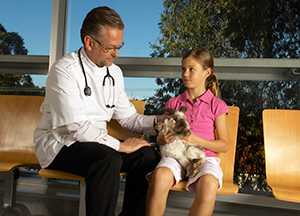
- Certain types of small mammal pets may not be suitable for your family. This guideline is particularly true if your household has young children, pregnant women, or people with weakened immune systems. People with weakened immune systems include the elderly and people with illnesses such as diabetes, HIV/AIDS, or cancer.
Choosing a small mammal
- Match a pet’s attitude, temperament, size, and activity level with your family, home, and the time you have to spend with your pet. If you want a pet that can be frequently handled and petted, do not choose a shy or aggressive pet in the hope it will adapt.

- Pick a small mammal pet that is bright, alert, and active. Small mammal pets should have a glossy coat free of droppings. Do not choose a pet from a cage when any other animals look sick. Signs of illness in a small mammal include appearing sluggish or depressed, having diarrhea, abnormal breathing, and fluid running from its eyes or nose.
- After selecting your new pet, take it to the veterinarian within a few days to a week after adoption for a health visit.
Housing your small mammal
- Learn how to properly care for your small animal. Find out what your pet needs in regards to food, daily activities, and environment. Proper care and nutrition for your pet will keep it healthy.
- Be aware that small mammals may shed Salmonella and other germs in their stool or urine. Avoid skin contact with animal droppings and urine, which may be infectious.
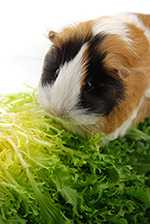
- Avoid bites and scratches from small mammals by learning how to approach and hold your pet safely.
- Avoid kissing or holding small mammals near your face.
- Keep your pet out of the kitchen or other areas where food is prepared. Do not eat while handling your pet.
- Wash your hands thoroughly with soap and water after handling small animals or their cages and bedding. Hand washing will reduce the risk of disease transmission from your pet to you and your family.
Monitor your pet’s health
- If your pet becomes sick or dies soon after purchase:
- Contact your veterinarian.
- Inform the pet store or breeder about the pet’s illness or death. Consider waiting before purchasing another pet from the same source.
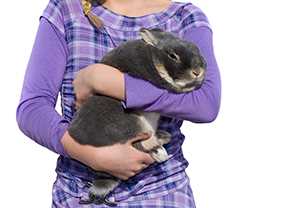
- Clean and disinfect the cage before reusing with another pet.
- Examine your small mammal daily, looking for any changes in activity level, appetite, or overall health. Specifically, look for sluggish or depressed behavior, dull hair coat, loose stool, discharge from the eyes or nose, or abnormal breathing, as these may be signs of underlying disease.
- Have your small mammal pet examined by a veterinarian regularly, especially if it becomes sick. Veterinarians who focus or specialize in small mammal pets can provide extra guidance on caring for your pet.
- If you become sick shortly after purchasing or adopting a pocket pet, tell your health care provider about your new pet.
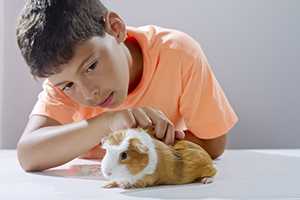
- Be aware that even though small mammals appear healthy, they may still spread germs and diseases to people and other animals.
What to do if bitten by a small mammal
Many types of germs can be spread from animal bites, even if the wound does not look very bad. If a bite from your small mammal breaks the skin, you should:
- Wash the wound with warm soapy water immediately. Even healthy pets can carry germs.
- Seek medical attention if:
- Pet appears sick.
- Your wound is serious.
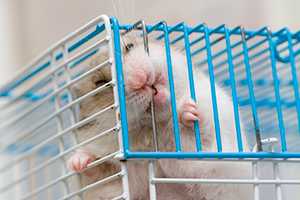
- Your wound becomes red, painful, warm, or swollen.
- Your last tetanus shot was more than 5 years ago.
- Your pet was housed outdoors or in contact with wildlife. Small mammals housed outside may be at risk for rabies.
Publications and materials
Brochures
Selecting a Rabbit
American Veterinary Medical Association
Selecting a Pet Rodent
American Veterinary Medical Association
Small mammal-associated outbreaks
Outbreak of multidrug-resistant Salmonella Tymphimurium associated with rodents purchased at retail pet stores – United States, December 2003-October 2004. Morbidity and Mortality Weekly Report. 2005 May 6; 54(17):429-433.
Eidson M, Matthews SD, Willsey AL, Cherry B, Rudd RJ, et al. Rabies virus infection in a pet guinea pig and seven pet rabbits. Journal of the American Veterinary Association. 2005;227(6):932-935.
Fatal Rat-Bite Fever – Florida and Washington, 2003. Morbidity and Mortality Weekly Report. 2005 Jan 27; 53(51 & 52):1198-1202.
Gaudie CM, Featherstone CA, Phillips WS, McNaught R, Rhodes PM, et al. Human Leptospira interrogans serogroup icterohaemorrhagiae infection (Weil’s disease) Acquired from Pet Rats. Veterinary Record 2008 Nov 15;163(20):599-601.
Lymphocytic Choriomeningitis Virus Infection in Organ Transplant Recipients – Massachusetts, Rhode Island, 2005. Morbidity and Mortality Weekly Report. 2005 Jun 3; 54(21):537-539.
Multistate Outbreak of Monkeypox – Illinois, Indiana, and Wisconsin, 2003. Morbidity and Mortality Weekly Report. 2003 Jun 13; 52(23):537-540.
Ninove L, Domart Y, Vervel C, Voinot C, et al. Cowpox Virus Transmission from Pet Rats to Humans, France. Emerging Infectious Diseases. 2009 May15; (5):781-784.
Tularemia Associated with a Hamster Bite – Colorado, 2004. Morbidity and Mortality Weekly Report. 2005 Jan 7; 53(51 & 52):1202-1203.
Research articles
Elliott SP. – Rat Bite Fever and Streptobacillus moniliformis. Clinical Microbiology Reviews.2007; 20(1):13-22.
Guarner J, Johnson BJ, Paddock CD, Shieh W, et al. Monkeypox transmission and pathogenesis in prairie dogs.Emerging Infectious Diseases. 2004; 10(3):426-431.
Additional information
Chitty J. Hendricks A. Zoonotic skin disease in small animals. In Practice. 2007; 29(2):92-97.
Pickering LK, Marano, NM, Bocchini JA, Angulo FJ.,et al. Exposure to Nontraditional Pets at Home and to Animals in Public Settings: Risks to Children. American Academy of Pediatrics. 2008; 122(4):876-886.
Riley PY, Chomel BB. Hedgehog zoonoses. Emerging Infectious Diseases. 2005; 11(1):1-5.
Smith A, Witfield Y. Household Pets and Zoonoses. National Collaborating Centre for Environmental Health. [cited August 27, 2015.] [PDF – 33 pages]
Smith KM, Smith KF, D’Auria JP. Exotic Pets: Health and Safety Issues for Children and Parents. Journal of Pediatric Health Care. 2012; 26(2): e2-e6.
- Page last reviewed: April 28, 2017
- Page last updated: April 28, 2017
- Content source:


 ShareCompartir
ShareCompartir